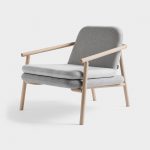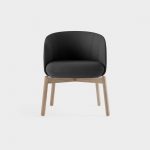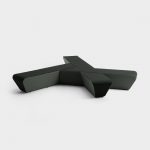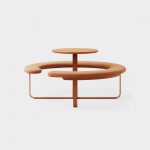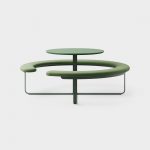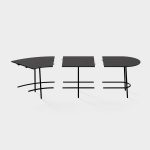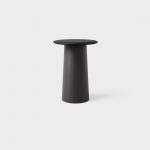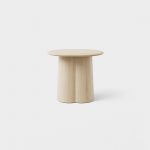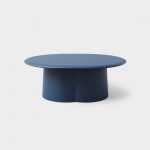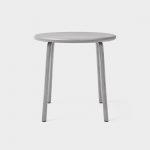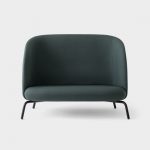
— Senior Interior Architect, Snøhetta.
Middlesex University, Interior Design, 1992.
How has the way we design our workplaces changed during the last 10 years?
There’s a move from individual offices to open and shared offices. More energy and resources are put into common areas and features. The need to move around is minimized as well, but when people sit closely together they have to have areas in which they can have informal meetings or talk on the phone. In consideration of my colleagues next to me I had to get up from my chair and move when you called me. Opening the office has brought with it better ventilation and sound, but it has also created a need for silence, privacy, better acoustics and temperature controlling.
A need for variation, I guess?
Yes. It’s a lot about flexibility and the use and misuse of energy. Part of the solution must be that we use less energy. In architecture and interior design, sustainability is not only represented where we live, but also where we work. It’s a very important factor we have to take into consideration. We have to create flexible solutions that don’t require too much energy. And fresh air! And air quality. Access to fresh air and just looking outside at the weather conditions create a better contact to the elements. It’s both nice and important to be able to get outside.
Do you think companies are aware of the importance of workplace design?
“No. It varies a lot. As humans we are good at adapting. But we are also fond of habits and doing what we know. I often experience the latter. People find a way to work, and it’s hard to change. But more today than 10 years ago I think companies acknowledge the importance of a good workplace. They can see it on the bottom line as well. If employees are happy, they produce more. Collaboration, indoor climate, inclusion and communication are all important. But it can be hard for companies to pinpoint exactly what’s missing in the office. It’s important to understand that the design of the workplace can contribute significantly to create a better company.”
It’s the small details.
“Indeed. When you have an open office, you have to carefully consider the risks of too much noise. It’s not like the direction we have been moving in during the last 50 years has the final answer. A perfect solution for one employee might not be good for another. People are different. And we have to see individuals even though we create general solutions. It’s very hard.”
In your opinion, what’s the most important or interesting trends in workplace design?
“I think it’s interesting to discuss how we work and what a person needs around him or her to be comfortable and create great work. In our office we have lots of different rooms, workshops and so on. Different people need to surround themselves with different things. I think it’s interesting to discover how different surroundings play a role in the way people work, think and collaborate.”
And what about your own office?
“In our own office we are constantly trying multiple things. Walking meetings where you move. Renting a cabin in the woods. Our most popular room is our canteen, which is just one large room. People like to have meetings here because it’s not a meeting room but just a big room, and it’s not only internal meetings but also with clients. Our office is intentionally not too polished. We want our guests to feel that they can basically leave their jacket wherever they want. If it’s too nice, our clients tend to be too hesitant and aloof because they feel inferior to us. We don’t want that. We have also experienced the opposite, that some clients have not been used to having meetings in an informal office setting like ours. In situations like those we have discussed whether we could dress differently or clean up the place to meet our client’s expectations. You have to be open to the idea that there might be a different format that’s more ideal in a given situation. It’s a balancing act.”
How do you believe workplaces are going to look in 5-10 years?
“I think the workspace has to be an extension of your life and your home. A place that feels familiar, that is your space. And at the same time not be too attached to your own corner in the office. In the future I think we are going to work more remotely. But remote work lacks natural communication with others, and that’s a very important factor to take into consideration. Not everything is digital. I think you have to have your own physical place. My best work happens when I communicate face to face with other people. And not just meet them in a cafe where I don’t have with me all the things I want to show them. I believe in flexible solutions, but I also believe we as humans need to feel us as a part of something bigger.”
Quote “I think the workspace has to be an extension of your life and your home. A place that feels familiar, that is your space.”
How does your own workspace look? Do you have your own table?
Yes I do. I have a traditional table and an ergonomic chair for my back. I have two screens. I have access to sofas and a massage chair. I’m also blessed with being able to walk outside on the quay and answer my phone. There’s lots of places I can move to, to vary my workspace.
When are you most effective?
I think it’s when I work with others in groups. I’m also very effective when I’m just myself and my head phones. But being creative and effective at the same time is best performed in a discussion with lots of input and following-up. That’s very effective.
What is the single most important factor in recent years that has significantly changed your work life for the better?
Since I had my son 10 years ago my work life changed significantly for the better: I became much better at prioritizing my time, communicating, and executing my projects.
And what part of your work life do you want to change next?
Covid-19 has forced us to travel a lot less in the future, and also be much more aware of what really matters. For that reason we have to develop new ways of communicating and learn again how to deliver a message without necessarily having our physical emotions on display like we did before. We need to be able to learn to read between the lines, and there’s still a long way to go when it comes to human interaction.
 SUMMIT Bench System
SUMMIT Bench System  TORNO Chair
TORNO Chair  SUI Desk Chair
SUI Desk Chair 














